

| Barnacles launch swimming nauplii into the plankton. They moult 6 times, followed by pre-settlement metamorphosis to a cyprid, then by post-settlement metamorphosis to a juvenile after settlement has been achieved. | |||
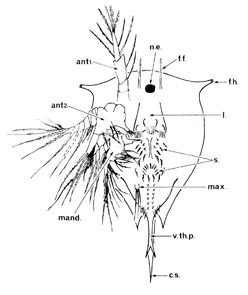
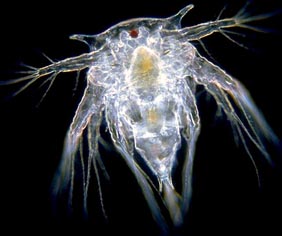
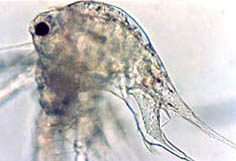
1. The Nauplius
Launched nauplii are the first of six naupliar larval stages. After two moults the stage III nauplius becomes planktotrophic, feeding mainly on diatoms and unicellular algae. The nauplius for is maintained through three further stages of growth and moulting, resulting after 10-14 days in a stage VI nauplius.
The short, broad body of nauplius (see the picture and figure above) results mainly from a precocious development, in functional larval form, of the anterior part of the head. The antennules, antennae and mandibles (ant1, ant2 and mand in the figure above) carry arrays of long setae and beat in a metachronal rhythm which generates a jerky forward swimming action. The same action during stages III-VI collects food particles from the water and passes them forward under the labrum. The number, form and arrangement of the setae on the naupliar limbs is important taxonomically and in identifying stages within a species.
Surprisingly, little is known of the behaviour of free-swimming barnacle nauplii. There are only 3 physical parameters in the environment with vector properties - Light direction, gravity and water flow. The other variables such as pressure and temperature, are scalar quantities and unless their variation in space can be detected, they give no information for larval orientation. Stage II S. balanoides larvae are positively phototactic when starved, but can become negatively phototactic after feeding on small diatoms. Positive phototaxia is a well known phenomenon among herbivorous zooplankton encouraging maintenance in the euphotic zone. The balance between the response to light and that to pressure combines with the swimming capabilities of the nauplius to maintain the larva within this zone.
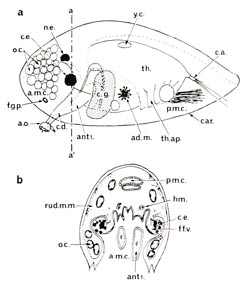
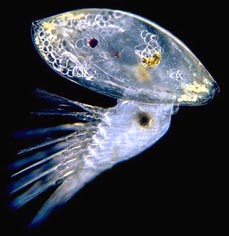
2. The Cyprid
Small or large, generalised or specialised, the next moult of the planktotrophic stage VI nauplis yields a change of form to a bibalved, non-feeding cyprid (see the figure and picture left). This, the search and settlement stage of the sequence, is able to seek out, identify and attach to a substratum appropriate to adult life.
The small cyprids of acorn barnacles have a survival time of at most a few days, and migrate to shallow-water benthic substrata in a manner typical of shallow water balanoids.
During metamorphosis the naupliar antennules are retained to form the adhesive organs of the cyprid, while the antennae and mendibles quickly regress. New swimming appendages, the thoracic limbs, are developed. Swimming propulsion is produced by the metachronal beating of the thoracic appendages which can provide lift as well as forward motion. The cyprid progresses in a series of minute bursts, rapidly accelerating on the propulsive stroke and almost as quickly decelerating on the recovery stroke. The movements are much quicker than those of the nauplius and they can give the false impression that the locomotor progress of the cyprid is quite smooth.
Under normal circumstances cyprids tend to swim in short bursts of 10-40 limb beats, unlike the nauplius which spends much of its time swimming. However, in the absence of strong stimuli the cyprid will hardly swim at all. The maximum sustained swimming speed of S. balanoides cyprids as 6.0 cm per second, which represents some 60-95 body length per second.
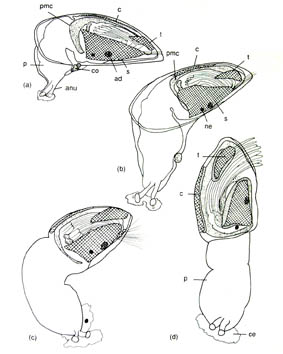
3. Post-settlement metamorphosis - the juvenile
Settlement of the cyprid is the precursor of another profound and rapid change. Associated with a single moult, a post-settlement metamorphosis transforms the cyprid into a juvenile with the general organisation of the future adult. Subsequent growth, with the intervention of future moults, is necessary before functional differentiation is completed and cirral feeding begins, but the initial transformation is the major one. In this process, the events in goose barnacles, leading to the pedunculate form, are more generalised than the metamorphosis of acorn barnacles to the sessile form. See the figures for the details of the major changes taking place post-settlement.
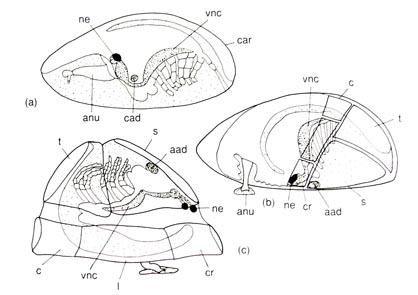
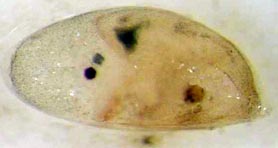
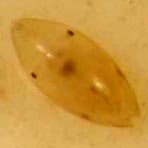
|
Category
|
Feeding
|
Planktonic Period
|
|
Planktotorophy (nauplius)
|
Yes
|
weeks to months
|
|
Pelagic lecithotorophy (cyprid)
|
No
|
hours to days
|
|
Non-pelagic lecithotorophy (fixed cyprid)
|
No
|
none
|